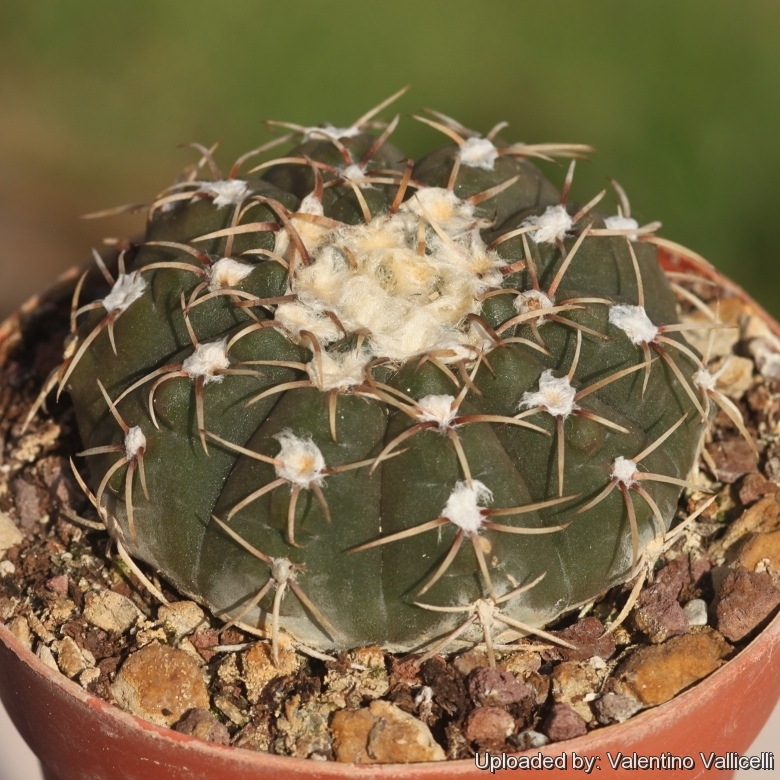= Gymnocalycium guerkeanum (Heese) Britton & Rose
Cactaceae (Britton & Rose) 3: 154, fig. 161 1922 [12 Oct 1922] Britton & Rose
Accepted Scientific Name: Gymnocalycium hyptiacanthum subs. uruguayense (Arechav.) Mereg.
Cactaceae Syst. Init. 24: 24. 2008 [Aug 2008]

Echinocactus platensis var. guerkeanus (Gymnocalycium guerkeanum) Photo by: Valentino Vallicelli
Origin and Habitat: Bolivia (Argentina?).
Synonyms:
See all synonyms of Gymnocalycium hyptiacanthum
Description: Gymnocalycium guerkeanumSN|21396]]SN|21396]] is one of the yellow-flowering Gymnocalyciums which is now considered a local or morphological form of the widespread and very variable Gymnocalycium hyptiacanthum subs. uruguayense, it is also closely related to Gymnocalycium artigasSN|21398]]SN|21398]] and (possibly) Gymnocalycium laeanum and all these may well be the same species.
Habit: Gymnocalycium guerkeanumSN|21396]]SN|21396]] is a small cactus species, usually solitary, but sometimes cespitose and barely rising above ground level.
Stem: Spherical or hemispherical, usually much depressed, 3-3,5(-8) cm tall, 5 (or more) cm in diameter, dull green.
Ribs: About 9 (or more), broad and obtuse, somewhat tuberculate.
Areoles: Orbicular, greyish tomentose when young.
Spines: All radial, usually 5, unequal, the longest 12 mm, long, yellowish, with brownish bases, rough, usually spreading or appressed.
Central spines: Absent.
Flowers: Few at any one time near centre of plant, yellow or greenish-yellow, nearly as broad as long when expanded; inner perianth-segments narrowly oblong, acute, sometimes toothed; scales on the ovary acute.
Subspecies, varieties, forms and cultivars of plants belonging to the Gymnocalycium hyptiacanthum group
Bibliography: Major references and further lectures
1) Edward Anderson “The Cactus family” Timber Press, Incorporated, 2001
2) David R Hunt; Nigel P Taylor; Graham Charles; International Cactaceae Systematics Group. "The New Cactus Lexicon" dh books, 2006
3) Bohdan Krisa “Illustrated Encyclopedia of Flowering Plants” Book Sales, 01/set/1993
4) N. L. Britton, J. N. Rose “The Cactaceae. Descriptions and Illustrations of Plants of the Cactus Family.” Volume 4, The Carnegie Institution of Washington, Washington 1923
5) Curt Backeberg “Die Cactaceae: Handbuch der Kakteenkunde” Gustav Fischer Verlag, Stuttgart New York 1982–1985
6) Edward Anderson “The Cactus family” Timber Press, Incorporated, 2001
7) James Cullen, Sabina G. Knees, H. Suzanne Cubey "The European Garden Flora Flowering Plants: A Manual for the Identification of Plants Cultivated in Europe, Both Out-of-Doors and Under Glass" Cambridge University Press, 11/Aug/2011
8) Jos Arechavaleta “Flora Uruguaya” 1905
9) H. Krainz “Die Kakteen: : eine Gesamtdarstellung der eingefuhrten Arten nebst Anzucht- und Pflege-Anweisungen Herausgegeben von H. Krainz.” Stuttgart 1969
Cultivation and Propagation: Gymnocalycium guerkeanumSN|21396]]SN|21396]] is a summer grower species that is easy to cultivate.
Growth rate: It is a relatively rapidly growing and easily flowering species that will make clumps given the best conditions.
Soils: It likes very porous standard cactus mix soil. Prefer a low pH compost, avoid substrata rich in limestone; otherwise growth will stop altogether.
Repotting: This plant needs plenty of space for its roots, repotting should be done every other year or when the it has outgrown its pot. Use pot with good drainage.
Watering: Needs moderate to copious waterings in summer, but do not overwater (Rot prone), keep dry in winter at a minimum temperature of 0°C.
Fertilization: Feed with a high potassium fertilizer in summer.
Hardiness: Reputedly resistant to frost if kept on the dry side prior to, and during, cold weather (hardy to -5 C ° C, or less for short periods).
Exposition: The plant tolerates extremely bright situations but enjoys filtered sunlight or afternoon shade, inside it needs bright light, and some direct sun. Tends to bronze in strong light, which encourages flowering and heavy spine production, but is likely to suffer from sun scorch or stunted growth if over exposed to direct sunlight during the hottest part of the day in summer.
Uses: It is an excellent plant for container growing. It always looks good and stays small. It look fine in a cold greenhouse and frame or outdoor in a rockery.
Pests & diseases: It may be attractive to a variety of insects, but plants in good condition should be nearly pest-free, particularly if they are grown in a mineral potting-mix, with good exposure and ventilation. Nonetheless, there are several pests to watch for:
- Red spiders: Red spiders may be effectively rubbed up by watering the plants from above.
- Mealy bugs: Mealy bugs occasionally develop aerial into the new growth among the wool with disfiguring results, but the worst types develop underground on the roots and are invisible except by their effects.
- Scales: Scales are rarely a problem.
- Rot: This species is particularly easy and accommodating, seldom suffer of cryptogamic diseases. Rot it is only a minor problem with gymnocalyciums if the plants are watered and “aired” correctly. If they are not, fungicides won't help all that much.
Propagation: Division, direct sow after last frost. Seeds germinate in 7-14 days at 21-27° C in spring, remove gradually the glass cover as soon the plants will be well rooted (ca 1-2 weeks) and keep ventilated, no full sun for young plants! To make a cutting twist off a branch and permit it to dry out a couple of weeks, lay it on the soil and insert the stem end partially into the soil. Try to keep the cutting somewhat upright so that the roots are able to grow downward.










